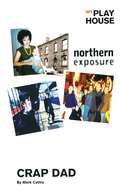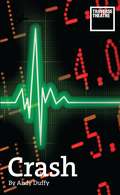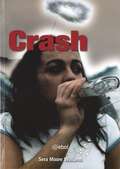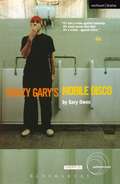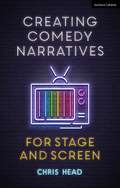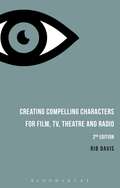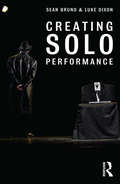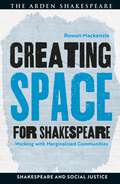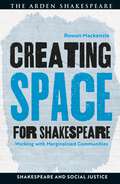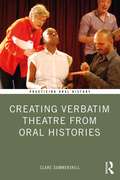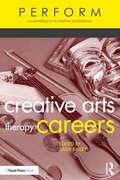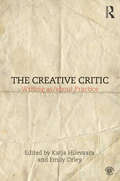- Table View
- List View
Crap Dad (Oberon Modern Plays Ser.)
by Mark Catley‘I drink too much, my toilet looks like a bomb site and I eat crisps for breakfast. I’m not fit to be someone’s father.’ When Paul meets Marie outside the headmaster’s office it’s hardly love at first sight. More like, ‘What you playing at you frigging psycho?’ And when the two teenages find out Marie is pregnant, things get a little dicey. But hindsight is a wonderful thing, and as a grown up Paul waits to meet his children for the first time it’s time for some serious thinking.
Crash (Oberon Modern Plays)
by Andy DuffyEverything that happens is created by you.' Confidence is everything in the world of high finance. Confidence in yourself, confidence in the market. Lose that and you lose everything. Crash is the story of an enigmatic trader attempting to rebuild his life following a tragic event. As he takes the first tentative steps back into the brutal landscape of trading stocks, he feels the pressure begin to build. In the continuing wake of the financial crisis, Scottish writer Andy Duffy creates a rare and poetic insight into the psychology of a banker’s world.
Crash (Modern Plays)
by William NicholsonCrash is a contemporary, satirical comedy, probing the feelings behind and reaction to the economic crisis and the people who caused it.The play follows a reunion of sorts, but on the basis of the characters' current situations, their common ground is at best elusive. Nick is a Securities Trader for Goldman Sachs and collector of art. Humphrey is an artist with ethics and a cheque he's not sure he should cash. And Christine is the beautiful girl they both loved, but Humphrey married. All together again, in Nick's Elizabethan mansion, getting ready to celebrate the unveiling of a new sculpture.But under the surface Humphrey is angry. Angry in the same way that the whole world is angry, angry about how people like Nick seem to have got away with causing a financial meltdown that affected everyone, but still manage to bank their bonuses.William Nicholson is the Tony and Academy award nominated author of Shadowlands and screenwriter on Gladiator and Elizabeth: The Golden Age as well as an acclaimed novelist. His new play seethes with the fury of a nation duped, alongside some sharp political humour about art, Collateralised Debt Obligations and ramblers.
Crash (Modern Plays)
by William NicholsonCrash is a contemporary, satirical comedy, probing the feelings behind and reaction to the economic crisis and the people who caused it.The play follows a reunion of sorts, but on the basis of the characters' current situations, their common ground is at best elusive. Nick is a Securities Trader for Goldman Sachs and collector of art. Humphrey is an artist with ethics and a cheque he's not sure he should cash. And Christine is the beautiful girl they both loved, but Humphrey married. All together again, in Nick's Elizabethan mansion, getting ready to celebrate the unveiling of a new sculpture.But under the surface Humphrey is angry. Angry in the same way that the whole world is angry, angry about how people like Nick seem to have got away with causing a financial meltdown that affected everyone, but still manage to bank their bonuses.William Nicholson is the Tony and Academy award nominated author of Shadowlands and screenwriter on Gladiator and Elizabeth: The Golden Age as well as an acclaimed novelist. His new play seethes with the fury of a nation duped, alongside some sharp political humour about art, Collateralised Debt Obligations and ramblers.
Crash
by Sera WilliamsDrama am dri chymeriad 15 oed. Mae Els yn cael pob gofal a chariad gan ei rhieni, ond mae'n ysu am ryddid a bywyd mwy cynhyrfus. Mae Wes yn bwy bywyd annibynnol, heb na gofal na chariad gan ei rieni. Ar ôl i Els a Wes ddisgyn mewn cariad, mae bywydau'r ddau yn newid yn gyflym iawn. [A play about three 15 year-olds. Els gets a lot of care and love from her parents, but she yearns for some freedom and a more exciting life. Wes live and independent life, without any care of love from his parents. When Els and Wes fall in love, their lives change very quickly.] Datganiad hawlfraint Gwneir y copi hwn dan dermau Rheoliadau (Anabledd) Hawlfraint a Hawliau mewn Perfformiadau 2014 i'w ddefnyddio gan berson sy'n anabl o ran print yn unig. Oni chaniateir gan gyfraith, ni ellir ei gopïo ymhellach, na'i roi i unrhyw berson arall, heb ganiatâd.
Crazy Gary's Mobile Disco (Modern Plays)
by Gary OwenSaturday night, small town Wales, one pub, one party and three lads stuck with their school reputations - the gimp, the geek and the bully. Their dream - to get the hell outWith a dead cat stuffed through a letterbox, a soupcon of mindless violence and the perfect girl to die for, Crazy Gary's Mobile Disco bristles with the desperately ordinary, the truly extraordinary, and the just plain mad. Heroic, comic and right up your street, director Vicky Featherstone's reputation for excellence coupled with Gary Owen's dazzling gist for storytelling, creates another unmissable hit for Paines Plough in a co-production with Sgript Cymru - national new writing company of Wales.Produced by Paines Plough, with Sgript Cymru, and directed by Vicky Featherstone, Crazy Gary's Mobile Disco premiered at the Chapter Arts Centre, Cardiff, in February 2001.
Crazy Gary's Mobile Disco: Crazy Gary's Mobile Disco - The Shadow Of A Boy - The Drowned World - Fags - Cancer Time (Modern Plays)
by Gary OwenSaturday night, small town Wales, one pub, one party and three lads stuck with their school reputations - the gimp, the geek and the bully. Their dream - to get the hell outWith a dead cat stuffed through a letterbox, a soupcon of mindless violence and the perfect girl to die for, Crazy Gary's Mobile Disco bristles with the desperately ordinary, the truly extraordinary, and the just plain mad. Heroic, comic and right up your street, director Vicky Featherstone's reputation for excellence coupled with Gary Owen's dazzling gist for storytelling, creates another unmissable hit for Paines Plough in a co-production with Sgript Cymru - national new writing company of Wales.Produced by Paines Plough, with Sgript Cymru, and directed by Vicky Featherstone, Crazy Gary's Mobile Disco premiered at the Chapter Arts Centre, Cardiff, in February 2001.
Creating Comedy Narratives for Stage and Screen
by Chris HeadThis accessible and engaging text covering sketch, sitcom and comedy drama, alongside improvisation and stand-up, brings together a panoply of tools and techniques for creating short and long-form comedy narratives for live performance, TV and online.Referencing a broad range of comedy from both sides of the Atlantic, spanning several decades and including material on contemporary internet sketches, it offers all kinds of useful advice on creating comic narratives for stage and screen: using life experience as raw material; constructing comedy worlds; creating comic characters, their relationships and interactions; structuring sketches, scenes and routines; and developing and plotting stories.The book's interviewees, from the UK and the USA, feature stand-ups, sketch comics, improvisers and TV comedy producers, and include Steve Kaplan, Hollywood comedy guru and author of The Hidden Tools of Comedy, Will Hines teacher and improviser from the Upright Citizens Brigade Theatre and Lucy Lumsden TV producer and former Controller of Comedy Commissioning for BBC.Written by “the ideal person to nurture new talent” (The Guardian), Creating Comedy Narratives for Stage & Screen includes material you won't find anywhere else and is a stimulating resource for comedy students and their teachers, with a range and a depth that will be appreciated by even the most eclectic and multi-hyphenated writers and performers.
Creating Comedy Narratives for Stage and Screen
by Chris HeadThis accessible and engaging text covering sketch, sitcom and comedy drama, alongside improvisation and stand-up, brings together a panoply of tools and techniques for creating short and long-form comedy narratives for live performance, TV and online.Referencing a broad range of comedy from both sides of the Atlantic, spanning several decades and including material on contemporary internet sketches, it offers all kinds of useful advice on creating comic narratives for stage and screen: using life experience as raw material; constructing comedy worlds; creating comic characters, their relationships and interactions; structuring sketches, scenes and routines; and developing and plotting stories.The book's interviewees, from the UK and the USA, feature stand-ups, sketch comics, improvisers and TV comedy producers, and include Steve Kaplan, Hollywood comedy guru and author of The Hidden Tools of Comedy, Will Hines teacher and improviser from the Upright Citizens Brigade Theatre and Lucy Lumsden TV producer and former Controller of Comedy Commissioning for BBC.Written by “the ideal person to nurture new talent” (The Guardian), Creating Comedy Narratives for Stage & Screen includes material you won't find anywhere else and is a stimulating resource for comedy students and their teachers, with a range and a depth that will be appreciated by even the most eclectic and multi-hyphenated writers and performers.
Creating Compelling Characters for Film, TV, Theatre and Radio
by Rib DavisStrong characters – characters we love and hate, those we despair for at their low moments and egg on to their triumphs – are the foundation of any successful script. Written by award-winning writer Rib Davis and now fully updated for its second edition, Creating Compelling Characters for Film, TV, Theatre and Radio is an authoritative practical guide to developing characters for professional and aspiring writers alike.As well as exploring character motivation, the interplay between character and plot, comic characters, heroes and villains, the new edition also includes a more in-depth look at character psychology, writing ensemble and multi-narrative dramas and the balance between character development and character revelation. The book also includes a wide range of contemporary examples from scripts ranging from films such as The Wolf of Wall Street and The Grand Budapest Hotel, award-winning plays such as Jerusalem and acclaimed TV shows such as Game of Thrones and True Detective.
Creating Compelling Characters for Film, TV, Theatre and Radio
by Rib DavisStrong characters – characters we love and hate, those we despair for at their low moments and egg on to their triumphs – are the foundation of any successful script. Written by award-winning writer Rib Davis and now fully updated for its second edition, Creating Compelling Characters for Film, TV, Theatre and Radio is an authoritative practical guide to developing characters for professional and aspiring writers alike.As well as exploring character motivation, the interplay between character and plot, comic characters, heroes and villains, the new edition also includes a more in-depth look at character psychology, writing ensemble and multi-narrative dramas and the balance between character development and character revelation. The book also includes a wide range of contemporary examples from scripts ranging from films such as The Wolf of Wall Street and The Grand Budapest Hotel, award-winning plays such as Jerusalem and acclaimed TV shows such as Game of Thrones and True Detective.
Creating Costumes for Devised Theatre
by Kyla KazuschykCreating Costumes for Devised Theatre combines perspectives from a variety of theatre practitioners to guide artists through the journey of creating costumes for devised work. Devised theatre can take a number of different forms, and it can be a challenge for the costume department to plan, organize, and assemble things for performers to wear while the entire shape of the piece is constantly changing. This book provides practical resources to guide the theatre artist through the journey of designing costumes as the characters are created. It addresses a wide range of questions, including how to adapt traditional methods of costume design to non-traditional practices, how to effectively collaborate with a team, and how to adapt costume technology practices to meet the needs of devising. Stories and photographs from performers, designers, technicians, directors, writers, educators, students, and activists working in the realm of devised theatre around the world are contextualized through the author's own involvement in unscripted, partially scripted, and otherwise dynamic drama, dance, and physical theatre to offer tangible solutions to streamline costume design and construction processes. This book is an invaluable guide for both experienced and novice costume designers, costume technicians, students, teachers, directors, managers, and theatre artists who exist in the spaces where all these roles overlap.
Creating Costumes for Devised Theatre
by Kyla KazuschykCreating Costumes for Devised Theatre combines perspectives from a variety of theatre practitioners to guide artists through the journey of creating costumes for devised work. Devised theatre can take a number of different forms, and it can be a challenge for the costume department to plan, organize, and assemble things for performers to wear while the entire shape of the piece is constantly changing. This book provides practical resources to guide the theatre artist through the journey of designing costumes as the characters are created. It addresses a wide range of questions, including how to adapt traditional methods of costume design to non-traditional practices, how to effectively collaborate with a team, and how to adapt costume technology practices to meet the needs of devising. Stories and photographs from performers, designers, technicians, directors, writers, educators, students, and activists working in the realm of devised theatre around the world are contextualized through the author's own involvement in unscripted, partially scripted, and otherwise dynamic drama, dance, and physical theatre to offer tangible solutions to streamline costume design and construction processes. This book is an invaluable guide for both experienced and novice costume designers, costume technicians, students, teachers, directors, managers, and theatre artists who exist in the spaces where all these roles overlap.
Creating Solo Performance
by Sean Bruno Luke DixonCreating Solo Performance is an innovative toolbox of exercises and challenges focused on providing you – the performer – with engaging and inspiring ways to explore and develop your idea both on the page and in the performance space. The creation of a solo show may be the most rewarding, liberating and stressful challenge you will take on in your career. This book acts as your silent collaborator as you develop your performance, by helpfully arranging exercises under the following headings: Beginnings Creating character Generating material Using your performance space Technology Endings Collaboration Exercises can be explored in sequence, at random or according to your specific needs and interests as a performer. By enabling you to create a bespoke formula that best applies to your specific subject, area of interest, style and discipline, this book will become an indispensable resource as you produce your solo show.
Creating Solo Performance
by Sean Bruno Luke DixonCreating Solo Performance is an innovative toolbox of exercises and challenges focused on providing you – the performer – with engaging and inspiring ways to explore and develop your idea both on the page and in the performance space. The creation of a solo show may be the most rewarding, liberating and stressful challenge you will take on in your career. This book acts as your silent collaborator as you develop your performance, by helpfully arranging exercises under the following headings: Beginnings Creating character Generating material Using your performance space Technology Endings Collaboration Exercises can be explored in sequence, at random or according to your specific needs and interests as a performer. By enabling you to create a bespoke formula that best applies to your specific subject, area of interest, style and discipline, this book will become an indispensable resource as you produce your solo show.
Creating Space for Shakespeare: Working with Marginalized Communities (Shakespeare and Social Justice)
by Rowan MackenzieApplied Shakespeare is attracting growing interest from practitioners and academics alike, all keen to understand the ways in which performing his works can offer opportunities for reflection, transformation, dialogue regarding social justice, and challenging of perceived limitations. This book adds a new dimension to the field by taking an interdisciplinary approach to topics which have traditionally been studied individually, examining the communication opportunities Shakespeare's work can offer for a range of marginalized people. It draws on a diverse range of projects from across the globe, many of which the author has facilitated or been directly involved with, including those with incarcerated people, people with mental health issues, learning disabilities and who have experienced homelessness. As this book evidences, Shakespeare can be used to alter the spatial constraints of people who feel imprisoned, whether literally or metaphorically, enabling them to speak and to be heard in ways which may previously have been elusive or unattainable. The book examines the use of trauma-informed principles to explore the ways in which consistency, longevity, trust and collaboration enable the development of resilience, positive autonomy and communication skills. It explores this phenomenon of creating space for people to find their own way of expressing themselves in a way that mainstream society can understand, whilst also challenging society to 'see better' and to hear better. This is not a process of social homogenisation but of encouraging positive interactions and removing the stigma of marginalization.
Creating Space for Shakespeare: Working with Marginalized Communities (Shakespeare and Social Justice)
by Rowan MackenzieApplied Shakespeare is attracting growing interest from practitioners and academics alike, all keen to understand the ways in which performing his works can offer opportunities for reflection, transformation, dialogue regarding social justice, and challenging of perceived limitations. This book adds a new dimension to the field by taking an interdisciplinary approach to topics which have traditionally been studied individually, examining the communication opportunities Shakespeare's work can offer for a range of marginalized people. It draws on a diverse range of projects from across the globe, many of which the author has facilitated or been directly involved with, including those with incarcerated people, people with mental health issues, learning disabilities and who have experienced homelessness. As this book evidences, Shakespeare can be used to alter the spatial constraints of people who feel imprisoned, whether literally or metaphorically, enabling them to speak and to be heard in ways which may previously have been elusive or unattainable. The book examines the use of trauma-informed principles to explore the ways in which consistency, longevity, trust and collaboration enable the development of resilience, positive autonomy and communication skills. It explores this phenomenon of creating space for people to find their own way of expressing themselves in a way that mainstream society can understand, whilst also challenging society to 'see better' and to hear better. This is not a process of social homogenisation but of encouraging positive interactions and removing the stigma of marginalization.
Creating the Character Costume: Tools, Tips, and Talks with Top Costumers and Cosplayers
by Cheralyn LambethMany beginning and hobbyist costumers believe that professional costume/prop builders have unlimited and specialized resources with which to ply their craft. Actually, the pros create things in much the same way that hobbyists do, working as resourcefully and creatively as possible with a limited budget. Creating the Character Costume dives into these methods to showcase how to achieve expert looks with limited means and lots of creativity. Part One explores tools, materials, and construction methods.
Creating the Character Costume: Tools, Tips, and Talks with Top Costumers and Cosplayers
by Cheralyn LambethMany beginning and hobbyist costumers believe that professional costume/prop builders have unlimited and specialized resources with which to ply their craft. Actually, the pros create things in much the same way that hobbyists do, working as resourcefully and creatively as possible with a limited budget. Creating the Character Costume dives into these methods to showcase how to achieve expert looks with limited means and lots of creativity. Part One explores tools, materials, and construction methods.
Creating Verbatim Theatre from Oral Histories (Practicing Oral History)
by Clare SummerskillOffering a roadmap for practicing verbatim theatre (plays created from oral histories), this book outlines theatre processes through the lens of oral history and draws upon oral history scholarship to bring best practices from that discipline to theatre practitioners. This book opens with an overview of oral history and verbatim theatre, considering the ways in which existing oral history debates can inform verbatim theatre processes and highlights necessary ethical considerations within each field, which are especially prevalent when working with narrators from marginalised communities. It provides a step-by-step guide to creating plays from interviews and contains practical guidance for determining the scope of a theatre project: identifying narrators and conducting interviews, developing a script from excerpts of interview transcripts and outlining a variety of ways to create verbatim theatre productions. By bringing together this explicit discussion of oral history in relationship to theatre based on personal testimonies, the reader gains insight into each field and the close relationship between the two. Supported by international case studies that cover a wide range of working methods and productions, including The Laramie Project and Parramatta Girls, this is the perfect guide for oral historians producing dramatic representations of the material they have sourced through interviews, and for writers creating professional theatre productions, community projects or student plays.
Creating Verbatim Theatre from Oral Histories (Practicing Oral History)
by Clare SummerskillOffering a roadmap for practicing verbatim theatre (plays created from oral histories), this book outlines theatre processes through the lens of oral history and draws upon oral history scholarship to bring best practices from that discipline to theatre practitioners. This book opens with an overview of oral history and verbatim theatre, considering the ways in which existing oral history debates can inform verbatim theatre processes and highlights necessary ethical considerations within each field, which are especially prevalent when working with narrators from marginalised communities. It provides a step-by-step guide to creating plays from interviews and contains practical guidance for determining the scope of a theatre project: identifying narrators and conducting interviews, developing a script from excerpts of interview transcripts and outlining a variety of ways to create verbatim theatre productions. By bringing together this explicit discussion of oral history in relationship to theatre based on personal testimonies, the reader gains insight into each field and the close relationship between the two. Supported by international case studies that cover a wide range of working methods and productions, including The Laramie Project and Parramatta Girls, this is the perfect guide for oral historians producing dramatic representations of the material they have sourced through interviews, and for writers creating professional theatre productions, community projects or student plays.
Creative Arts Therapy Careers: Succeeding as a Creative Professional (ISSN)
by Sally BaileyCreative Arts Therapy Careers is a collection of essays written by and interviews with registered drama therapists, dance/movement therapists, music therapists, art therapists, poetry therapists, and expressive arts therapists.The book sheds light on the fascinating yet little-known field of the creative arts therapies – psychotherapy approaches which allow clients to use creativity and artistic expression to explore their lives, solve their problems, make meaning, and heal from their traumas. Featuring stories of educators in each of the six fields and at different stages of their career, it outlines the steps one needs to take in order to find training in one of the creative arts therapies and explores the healing aspects of the arts, where creative arts therapists work, who they work with, and how they use the arts in therapy. Contributors to this book provide a wealth of practical information, including ways to find opportunities to work with at-risk populations in order to gain experience with the arts as healing tools; choosing the right graduate school for further study; the difference between registration, certification, and licensure; and the differences between a career in a medical, mental health, educational, correctional, or service institution.This book illuminates creative arts therapy career possibilities for undergraduate and graduate students studying acting, directing, playwriting, creative writing, visual arts, theatre design, dance, and music. It is also an excellent resource for instructors offering a course to prepare arts students of all kinds for the professional world.
Creative Arts Therapy Careers: Succeeding as a Creative Professional (ISSN)
by Sally BaileyCreative Arts Therapy Careers is a collection of essays written by and interviews with registered drama therapists, dance/movement therapists, music therapists, art therapists, poetry therapists, and expressive arts therapists.The book sheds light on the fascinating yet little-known field of the creative arts therapies – psychotherapy approaches which allow clients to use creativity and artistic expression to explore their lives, solve their problems, make meaning, and heal from their traumas. Featuring stories of educators in each of the six fields and at different stages of their career, it outlines the steps one needs to take in order to find training in one of the creative arts therapies and explores the healing aspects of the arts, where creative arts therapists work, who they work with, and how they use the arts in therapy. Contributors to this book provide a wealth of practical information, including ways to find opportunities to work with at-risk populations in order to gain experience with the arts as healing tools; choosing the right graduate school for further study; the difference between registration, certification, and licensure; and the differences between a career in a medical, mental health, educational, correctional, or service institution.This book illuminates creative arts therapy career possibilities for undergraduate and graduate students studying acting, directing, playwriting, creative writing, visual arts, theatre design, dance, and music. It is also an excellent resource for instructors offering a course to prepare arts students of all kinds for the professional world.
The Creative Critic: Writing as/about Practice
by Katja Hilevaara Emily OrleyAs practitioner-researchers, how do we discuss and analyse our work without losing the creative drive that inspired us in the first place? Built around a diverse selection of writings from leading researcher-practitioners and emerging artists in a variety of fields, The Creative Critic: Writing as/about Practice celebrates the extraordinary range of possibilities available when writing about one’s own work and the work one is inspired by. It re-thinks the conventions of the scholarly output to propose that critical writing be understood as an integral part of the artistic process, and even as artwork in its own right. Finding ways to make the intangible nature of much of our work ‘count’ under assessment has become increasingly important in the Academy and beyond. The Creative Critic offers an inspiring and useful sourcebook for students and practitioner-researchers navigating this area. Please see the companion site to the book, http://www.creativecritic.co.uk, where some of the chapters have become unfixed from the page.
The Creative Critic: Writing as/about Practice
by Katja Hilevaara Emily OrleyAs practitioner-researchers, how do we discuss and analyse our work without losing the creative drive that inspired us in the first place? Built around a diverse selection of writings from leading researcher-practitioners and emerging artists in a variety of fields, The Creative Critic: Writing as/about Practice celebrates the extraordinary range of possibilities available when writing about one’s own work and the work one is inspired by. It re-thinks the conventions of the scholarly output to propose that critical writing be understood as an integral part of the artistic process, and even as artwork in its own right. Finding ways to make the intangible nature of much of our work ‘count’ under assessment has become increasingly important in the Academy and beyond. The Creative Critic offers an inspiring and useful sourcebook for students and practitioner-researchers navigating this area. Please see the companion site to the book, http://www.creativecritic.co.uk, where some of the chapters have become unfixed from the page.
